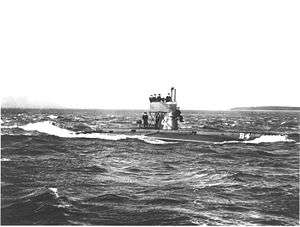HMS B4
HMS B4 was one of 11 B-class submarines built for the Royal Navy in the first decade of the 20th century. The boat survived the First World War and was sold for scrap in 1919.
 | |
| History | |
|---|---|
| Name: | HMS B4 |
| Builder: | Vickers |
| Launched: | 14 November 1905 |
| Completed: | 28 January 1906 |
| Fate: | Sold for scrap, 1 April 1919 |
| General characteristics | |
| Class and type: | B-class submarine |
| Displacement: |
|
| Length: | 142 ft 3 in (43.4 m) |
| Beam: | 12 ft 7 in (3.8 m) |
| Draught: | 11 ft 2 in (3.4 m) |
| Installed power: | |
| Propulsion: |
|
| Speed: |
|
| Range: | 1,000 nmi (1,900 km; 1,200 mi) at 8.7 kn (16.1 km/h; 10.0 mph) on the surface |
| Test depth: | 100 feet (30.5 m) |
| Complement: | 2 officers and 13 ratings |
| Armament: | 2 × 18 in (450 mm) bow torpedo tubes |
Design and description
The B class was an enlarged and improved version of the preceding A class. The submarines had a length of 142 feet 3 inches (43.4 m) overall, a beam of 12 feet 7 inches (3.8 m) and a mean draft of 11 feet 2 inches (3.4 m). They displaced 287 long tons (292 t) on the surface and 316 long tons (321 t) submerged. The B-class submarines had a crew of two officers and thirteen ratings.[1]
For surface running, the boats were powered by a single 16-cylinder 600-brake-horsepower (447 kW) Vickers petrol engine that drove one propeller shaft. When submerged the propeller was driven by a 180-horsepower (134 kW) electric motor. They could reach 12 knots (22 km/h; 14 mph) on the surface and 6.5 knots (12.0 km/h; 7.5 mph) underwater.[1] On the surface, the B class had a range of 1,000 nautical miles (1,900 km; 1,200 mi) at 8.7 knots (16.1 km/h; 10.0 mph).[2]
The boats were armed with two 18-inch (450 mm) torpedo tubes in the bow. They could carry a pair of reload torpedoes, but generally did not as they would have to remove an equal weight of fuel in compensation.[3]
Construction and career
B4 was built by Vickers at their Barrow-in-Furness shipyard, launched on 14 November 1905 and completed on 28 January 1906.[4]
B4 collided with a dredger when entering Portsmouth harbour on 21 July 1906 and was badly damaged as a result, having to be beached before being taken into dry dock for repair.[5] When the war began in 1914, the boat was assigned to defend the Straits of Dover. B4 was sold for breaking up on 1 April 1919 to the Ardrossan Dry Dock Co.
Notes
- Gardiner & Gray, p. 87
- Akermann, p. 123
- Harrison, Chapter 27
- Harrison, A. N. (2018) [1979, London: Ministry of Defence]. "Appendix I: List of RN Submarines in the 1901 to 1936 Programmes" (PDF). BR3043: The Development of British Submarines: From Holland No. 1 (1901) to HMS Porpoise (1930). RN Subs: Website of the Barrow Submariners Association. Retrieved 25 March 2018.
- "Naval Matters—Past and Prospective: Portsmouth Dockyard". The Marine Engineer and Naval Architect. Vol. 29. 1 September 1906. p. 41.
References
- Akermann, Paul (2002). Encyclopaedia of British Submarines 1901–1955 (reprint of the 1989 ed.). Penzance, Cornwall: Periscope Publishing. ISBN 1-904381-05-7.
- Gardiner, Robert & Gray, Randal, eds. (1985). Conway's All the World's Fighting Ships: 1906–1921. Annapolis, Maryland: Naval Institute Press. ISBN 0-85177-245-5.
- Harrison, A. N. (January 1979). "The Development of HM Submarines From Holland No. 1 (1901) to Porpoise (1930) (BR3043)". United Kingdom Ministry of Defence. Retrieved 16 September 2019 – via Submariners Association: Barrow in Furness Branch.
- Kemp, Paul & Jung, Peter (1989). "Five Broken Down B Boats: British Submarine Operations in the Northern Adriatic 1915–1917". Warship International. XXVI (1): 10–29. ISSN 0043-0374.
- Wilson, Michael (1981). "The British 'B' Class Submarine". In Roberts, John (ed.). Warship Volume V. London: Conway Maritime Press. pp. 38–44, 74–79. ISBN 0-85177-244-7.